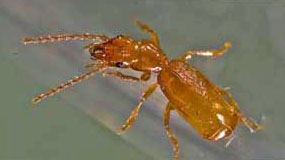Rock Crevice Fauna
Having recently become very much more interested in the beetles, Coleoptera, of Cornwall, I have looked for some that actually live between high and low water marks, inhabiting rock crevices where, presumably, small pockets of trapped air enable them to survive when the tide is in.
 Aepus robinii © S Trewhella
Aepus robinii © S Trewhella
In summer 2006 several visits were made to the shores between Prisk Cove and The Bar, Helford Passage to look for the two particular small beetles Aepus robinii and Aepus marinus – no common names. My first visit to Prisk Cove involved moving ‘slabs’ of loose rock to reveal the sand-filled rock crevices below. This specialised habitat revealed a whole variety of different animals – centipedes, gastropds (snail like molluscs) and mites to name but a few. A short search of one crevice yielded a pale, yellow-brown 2-3mm beetle. This was Aepus robiniicharacterised by eyes protruding slightly from the side of its head and smooth, lobed wing cases with 3 or 4 very long stiff hairs on each.
Also present in the crevice were large numbers of the familiar grey-blue collembola (springtails) Anurida maritima, often seen as ‘rafts’ in rock pools, on which the beetles probably feed. Aepus robinii is a Nationally Scarce (B) species with a more southern European distribution extending from southern Britain along the Atlantic coast of France and Spain to the Mediterranean area.Although the second and somewhat rarer A. marinus was not found then, two other interesting and rare species, the pseudoscorpionNeobisium maritimum and the bizarre and somewhat obscure Echiuran worm Thalassema thalassemumwere found sharing the same habitat as A. robinii. The greatly enlarged and pincer-like second pair of appendages of Neobisium maritimumgive it a superficail appearance of a tail-less scorpion, hence the name pseudo-scorpion. N. maritimum is about 3mm long and is a rich olive-brown in colour. This Nationally Scarce (A) species is perhaps nowhere more common in Britain than on the Cornish coastline.
Thalassema thalassemum, an obscure, unsegmented ‘worm’ also prefers mud and sand filled crevices especially on the lower shore. The main body is 2-3 cm long with an extensible proboscis 1 – 20 cm long, tapering to a point, altogether a rather strange animal! A provisionally Nationally Scarce species it occurs northwards from the Mediterranean to southern Britain where they are relatively common in Cornwall and Devon but very rare elsewhere.
The second Aepus beetle, A marinus, was later found on or about the high water mark between the Ferryboat Inn and The Bar. Whereas this does occur as part of the rock crevice fauna its preferred habitat is under stones lying flat on fine sand or shingle. This Nationally Scarce (B) and Biodiversity Action Plan (BAP) species has a much more restricted distribution range extending from southern Norway along the English Channel to northern Brittany. About the same size and colour as A.robinii it has greatly reduced, non-protruding eyes, and square-cut downy wing-cases.
Since the original search for the above species they have been found in good numbers throughout the search area, yet a further piece of evidence of the importance of the Helford Estuary, and near confines, for rare and interesting species!
N.B. After removing the loose ‘slabs’ of rock and examining the rock crevices beneath, each slab was replaced carefully in exactly the original position.
Dr Paul A Gainey
Extract from HVMCA newsletter No.36 Spring 2008







